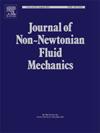Analysis of the shear thickening behavior of a fumed silica suspension using QL-LAOS approach
IF 2.8
2区 工程技术
Q2 MECHANICS
引用次数: 0
Abstract
The feasibility of applying quasi-linear large amplitude oscillatory shear (QL-LAOS) approach to a shear thickening (ST) fumed silica suspension was tested. While the characteristic time has been used as the parameter for the original QL-LAOS analysis of shear thinning fluids, we obtained that a description based upon increasing stiffness is more appropriate for ST fumed silica suspensions. Very low third to first harmonics ratio were obtained indicating the need of alternative criteria to identify QL-LAOS behavior in ST suspensions. Consequently, a method based upon the best fit of an ellipse to the experimental Lissajous-Bowditch curves was proposed. Compliances were obtained from areas of viscous and elastic fitted ellipses. The dependence of the material functions obtained by using a Jeffrey´s mechanical viscoelastic framework with angular frequency supports the idea of ST microstructure evolves by increasing with shear the number of small hydroclusters.
气相二氧化硅悬浮液的剪切增厚行为分析
对拟线性大振幅振荡剪切(QL-LAOS)方法应用于剪切增稠(ST)气相二氧化硅悬浮液的可行性进行了试验。虽然特征时间已被用作剪切变稀流体的原始qi - laos分析的参数,但我们得到基于增加刚度的描述更适合于ST气相二氧化硅悬浮液。得到了非常低(≤1.5)的三次谐波与一次谐波之比,这表明需要替代标准来识别ST悬液中的QL-LAOS行为。因此,提出了一种基于椭圆与实验Lissajous-Bowditch曲线最佳拟合的方法。从黏性和弹性拟合椭圆的区域获得柔度。使用Jeffrey’s机械粘弹性框架获得的材料函数与角频率的相关性支持了ST微观结构随着剪切量的增加而发展的观点。
本文章由计算机程序翻译,如有差异,请以英文原文为准。
求助全文
约1分钟内获得全文
求助全文
来源期刊
CiteScore
5.00
自引率
19.40%
发文量
109
审稿时长
61 days
期刊介绍:
The Journal of Non-Newtonian Fluid Mechanics publishes research on flowing soft matter systems. Submissions in all areas of flowing complex fluids are welcomed, including polymer melts and solutions, suspensions, colloids, surfactant solutions, biological fluids, gels, liquid crystals and granular materials. Flow problems relevant to microfluidics, lab-on-a-chip, nanofluidics, biological flows, geophysical flows, industrial processes and other applications are of interest.
Subjects considered suitable for the journal include the following (not necessarily in order of importance):
Theoretical, computational and experimental studies of naturally or technologically relevant flow problems where the non-Newtonian nature of the fluid is important in determining the character of the flow. We seek in particular studies that lend mechanistic insight into flow behavior in complex fluids or highlight flow phenomena unique to complex fluids. Examples include
Instabilities, unsteady and turbulent or chaotic flow characteristics in non-Newtonian fluids,
Multiphase flows involving complex fluids,
Problems involving transport phenomena such as heat and mass transfer and mixing, to the extent that the non-Newtonian flow behavior is central to the transport phenomena,
Novel flow situations that suggest the need for further theoretical study,
Practical situations of flow that are in need of systematic theoretical and experimental research. Such issues and developments commonly arise, for example, in the polymer processing, petroleum, pharmaceutical, biomedical and consumer product industries.

 求助内容:
求助内容: 应助结果提醒方式:
应助结果提醒方式:


